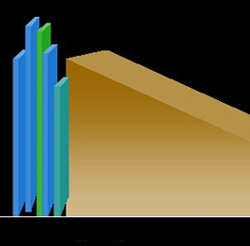
Advanced Parameters Continued
High and low frequency attenuation. These parameters restrict the frequencies going into the reverb.
If your reverb sounds metallic, try reducing the highs starting at 4 – 8kHz. Note that many of the great-sounding plate reverbs didn’t have much response above 5 kHz, so don’t worry if your reverb doesn’t provide a high frequency brilliance – it’s not crucial.
Reducing low frequencies going into reverb reduces muddiness; try attenuating from 100 – 200Hz on down.
Early reflections diffusion (sometimes just called diffusion). Increasing diffusion pushes the early reflections closer together, which thickens the sound.
Reducing diffusion produces a sound that tends more toward individual echoes than a wash of sound. For vocals or sustained keyboard sounds (organ, synth), reduced diffusion can give a beautiful reverberant effect that doesn’t overpower the source sound.
On the other hand, percussive instruments like drums work better with more diffusion, so there’s a smooth, even decay instead of what can sound like marbles bouncing on a steel plate (at least with inexpensive reverbs). You’ll hear the difference in the following two audio examples.
Maximum Diffusion – No Diffusion
The reverb tail itself may have a separate diffusion control (the same general guidelines apply about setting this), or both diffusion parameters may be combined into a single control.
Early reflections pre-delay. It takes a few milliseconds before sounds hit the room surfaces and start to produce reflections.
This parameter, usually variable from 0 to around 100ms, simulates this effect. Increase the parameter’s duration to give the feeling of a bigger space; for example, if you’ve dialed in a large room size, you’ll probably want to add a reasonable amount of pre-delay as well.
Reverb density. Lower densities give more space between the reverb’s first reflection and subsequent reflections. Higher densities place these closer together. Generally, I prefer higher densities on percussive content, and lower densities for vocals and sustained sounds.
Early reflections level. This sets the early reflections level compared to the overall reverb decay; balance them so that the early reflections are neither obvious, discrete echoes, nor masked by the decay. Lowering the early reflections level also places the listener further back in the hall, and more toward the middle.
High frequency decay and low frequency decay. Some reverbs have separate decay times for high and low frequencies. These frequencies may be fixed, or there may be an additional crossover parameter that sets the dividing line between low and high frequencies.
These controls have a huge effect on the overall reverb character. Increasing the low frequency decay creates a bigger, more “massive” sound.
Increasing high frequency decay gives a more “ethereal” type of effect. With few exceptions this is not the way sound works in nature, but it can sound very good on vocals as it adds more reverb to sibilants and fricatives, while minimizing reverb on plosives and lower vocal ranges. This avoids a “muddy” reverberation effect that doesn’t compete with the vocals.
For more audio/sound related content and resources, go to Audiofanzine.
